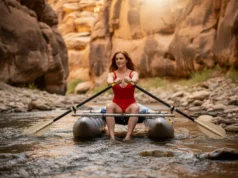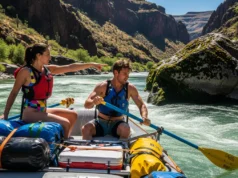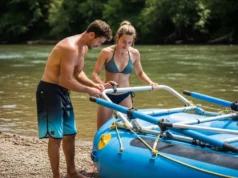In this article
The oars feel heavy in your hands, the raft sluggish against the pull of the current. Ahead, the river quickens, its surface telling a story you don’t yet know how to read. That feeling of uncertainty is where every great river pilot begins. This guide is your translator. We will deconstruct the whitewater oar stroke, not as a set of rigid instructions, but as a dynamic language of leverage and momentum. Mastering this stroke technique allows you to have a conversation with the river, turning its power into your precise control.
To master these basic oar strokes, we will focus on the essentials that build true confidence on the water.
- Why Rafting is Different: Understand the fundamental physics and goals that separate a whitewater rafting oar stroke from competitive rowing.
- The Universal Phases: Break down every maneuver into its three core components—the Catch, Drive, and Recovery.
- Your Primary Toolkit: Master the two most essential strokes for river control: the Forward Stroke and the Back (Pull) Stroke.
- From Fault to Finesse: Learn to identify and correct the most common mistakes to accelerate your learning curve.
Why is a Rafting Oar Stroke Fundamentally Different?
Before you take your first stroke, we need to dismantle a common but incorrect mental model: the idea that rowing a raft is anything like the sleek, speed-focused rowing (sport) you see in the Olympics. They are two different languages spoken for two entirely different purposes. Traditional rowing often involves shell boats with sliding seats designed for maximum propulsion on flat water. Whitewater technique is a different discipline entirely, dictated by unique equipment and a chaotic environment.
What is the Primary Goal of a Whitewater Oar Stroke?
In competitive rowing, the objective is simple: maximum velocity and linear efficiency. The athlete is a finely tuned engine, and the strength of the rowing stroke comes from the legs. A whitewater rafter, however, is a technical pilot responsible for navigating rivers and maneuvering rapids from a fixed seat. Your primary goals are control, maneuverability, and safety. You are maneuvering a heavy, high-drag inflatable craft—an oar rig—often loaded with gear and passengers, that requires immense and strategic force to alter its course. This context reframes your job from that of a racer to that of a pilot, whose primary responsibility is precision navigation.
The river itself is your partner and your adversary. Its powerful current is a constant force you must work with, against, or across. Unlike a straight race course, a river presents constant obstacles—rocks, waves, and hydraulics—that demand immediate and often corrective actions. The brute-force approach of a sprinter is not only inefficient here, it’s unsustainable. Due to The physics of hydrodynamic drag, doubling the speed of a raft can require an eightfold increase in power. Effective rafting, therefore, prioritizes leverage and efficiency, using the oars to strategically position the boat rather than just mindlessly propelling it forward.
| Feature | Whitewater Rafting (Fixed Seat) | Competitive Rowing (Sliding Seat) |
|---|---|---|
| Primary Goal | Control, Stability, Maneuverability | Speed, Linear Efficiency |
| Environment | Dynamic, turbulent whitewater | Flat, straight course |
| Seat Type | Fixed Thwart/Seat | Sliding Seat |
| Primary Power Source | Core, Back, Legs (bracing) | Legs (driving), Back, Arms |
| Key Maneuver | Back Ferry (slowing for control) | Power 10 (burst of speed) |
| Oar Design | Heavy-duty, robust construction | Lightweight carbon fiber, aerodynamic |
| Stroke Focus | Solid Catch, controlled power application | Explosive Drive, efficient Recovery |
With this core purpose of control established, let’s break down the physical building blocks that make this control possible. This is the foundation of a comprehensive guide on how to row a raft, and understanding the ‘why’ is the first step.
What Are the Universal Phases of Every Oar Stroke?
Every single maneuver you will ever make in a raft, from a simple forward push to a complex ferry across a rapid, can be universally deconstructed into three phases to a stroke. A rowing stroke is composed of the Catch, the Drive, and the Recovery. These are the atomic units of your conversation with the river. Master these phases of the oar stroke, and you can build any sentence you need.
How Does the “Catch” Initiate Power and Control?
The Catch is the first part of the stroke, the moment the oar blade is placed in the water. All subsequent power depends on this instant. The goal is a clean, solid, and immediate connection, achieved as the athlete drops the oarblade vertically into the water until it is fully submerged. This precise blade placement must happen before you apply any significant power to the oar handle. A proper Catch sets the oarblade as a stable anchor point—a fulcrum—against which you will lever the massive raft. Think of it as setting a post in the water; the firmer the post is set, the more effectively you can pull or push the boat past it.
A common mistake is “washing out” or splashing, where the blade enters at a poor angle, creating air bubbles and severely reducing its grip. Another error is applying power too early, which causes the blade to slip backward uselessly before it is fully planted, wasting precious energy. In the chaotic water of a river, a solid Catch is non-negotiable. It provides the instant response needed to make a corrective move or hold a precise line through a complex channel.
Pro-Tip: Listen with your blades. A proper Catch is quiet. If you hear a loud “slap” or “plunk,” it means you’re striking the surface and creating turbulence instead of making a clean connection. Focus on letting the oar’s weight drop it into the water, and only begin the Drive when you feel the solid, quiet resistance of the river.
Once the blade is securely “caught” in the water, the real work of moving the raft begins.
What is the Correct Biomechanics for the “Drive” Phase?
The Drive, or Power Phase, is where the power applied is transferred through the oars to move the raft. This is the heart of the stroke, where proper body mechanics are critical for generating a powerful stroke. This is a whole-body movement. The motion begins with leg power, as your legs push against a fixed brace. This force is then transferred through strong core engagement and a stable back position, and is finally delivered as you draw the oarblades through the water with your arms. At the end of the Drive is the Finish (or Release), where you cleanly extract the blade from the water. This is the official curriculum for oar rafting instruction for a reason: it’s powerful and sustainable.
Your core is the critical link in this chain. A weak core results in “arm-rowing,” a classic beginner mistake that leads to a weak stroke and rapid fatigue. The correct feeling is not one of “pulling the water,” but of anchoring the oar blade and powerfully levering the raft past that fixed point. A proper layback at the Finish maximizes the stroke’s length. This full-body engagement ensures you develop true paddling strength, by connecting your entire body to the oar.
After powerfully driving the raft past the oars, the stroke must be completed cleanly to prepare for the next stroke.
What Defines an Efficient “Recovery”?
The Recovery is the final phase, where the oar is removed from the water and repositioned for the next Catch. The primary goal here is an efficient and clean exit of the blade that avoids disrupting the boat’s momentum. For rowers using open oarlocks, this is the moment for “feathering“—turning the feathering blade parallel to the water’s surface. This feathering position reduces wind resistance and, more importantly, prevents the blade from catching on waves, a critical skill in whitewater.
However, the Recovery in rafting is less about aerodynamic efficiency and more about preparing for the next, often immediate, maneuver. Many beginner setups use systems like “oar rights,” a popular device that keeps the blade perpendicular to the water and prevents feathering. These systems act as “training wheels,” removing complexity and allowing novices to focus on the core motions of the Catch and Drive. An efficient recovery is quick but controlled, positioning you and your oars to be instantly ready for the river’s next command. When thinking about gear, understanding these systems is part of your rafting oar selection.
Now that we’ve assembled the universal building blocks of a stroke, we can combine them to create the two primary strokes in your toolkit.
How Do You Execute the Two Primary Strokes for River Control?
This is where theory becomes practice. We now translate the foundational phases—Catch, Drive, Recovery—into the two most critical and opposing maneuvers that provide the majority of control on a river. These are your “gas” and your “brakes.”
The Forward (Push) Stroke: When and How to Gain Speed?
The Forward Stroke is your gas pedal. It is a propulsion stroke used to move the raft faster than the current. To perform a forward stroke, you face downstream, lean forward from the hips, and perform a Catch by planting the blades in the water behind you. The Drive phase is a powerful pushing motion that propels the bow forward; the stroke starts with the grips close to the chest, you extend your arms and rotate your torso to push the oar handles away from your body. The body mechanics are often compared to a “bench press,” as it uses triceps, chest, and shoulders, all stabilized by strong core rotation.
This stroke is used strategically, not constantly. It’s the right tool for punching through large waves or holes where maintaining momentum is critical for a clean passage. It’s also used for aggressive downstream moves, like catching an eddy on the opposite side of the river. Because it relies on the smaller “pushing” muscles, it’s generally less powerful and more fatiguing than the Back Stroke. When used on just one side, a powerful push stroke is the key to Executing a pivot turn.
While moving faster than the current is useful, the real key to safety and precision lies in the ability to slow down.
The Back (Pull) Stroke: Why is This the Ultimate Control Maneuver?
The Back Stroke is your brakes, your steering, and your most critical safety tool. It is the primary defensive and maneuvering stroke in whitewater rafting, used for slowing down the boat relative to the current. This is essentially rowing backwards. Facing downstream, you reach forward, perform a solid Catch, and then execute the Drive by pulling the oar handles toward your chest. This is your most powerful stroke because it allows you to brace your feet firmly and engage the entire kinetic chain: legs, core, back, and biceps. This pulling motion is biomechanically stronger and far more sustainable than the forward push.
Slowing down slows the boat and is a superpower on the river. It gives you more time to think, read the water, and perfectly position the raft for an upcoming obstacle. This stroke is the mechanical foundation of the Back Ferry, the single most important safety and maneuvering technique in rafting that increases maneuverability. By angling the boat relative to the current and using back strokes to move slower than the water, you can achieve controlled lateral movement across the river. Mastering the Back Stroke is the first major step toward gaining true command of the raft, and it is the core skill you need to Master the art of raft ferrying.
Pro-Tip: Your ferry angle determines your lateral speed and direction. A common error is over-angling the raft, causing the current to grab your upstream side and spin you out. Start with a subtle angle relative to the current—just enough to feel the water pressing against the boat. Small, controlled pull strokes will do the work. You can always add more angle, but it’s very difficult to recover from too much.
With these foundational strokes in your arsenal, the final step is to refine your technique and build the muscle memory that turns action into instinct.
Conclusion
The whitewater oar stroke is a discipline of control and maneuverability, fundamentally different from the speed-oriented stroke of competitive rowing. Every action you take is built from the three phases of the oar stroke: a solid Catch to anchor the blade, a full-body Drive to move the boat, and a clean Recovery to prepare for the next move. Your power originates from your legs pushing against a brace, transferred through an engaged core into the oars. And of all the strokes at your disposal, the Back Stroke is the most powerful and critical maneuver, allowing you to slow down, gain time, and set up for precise lateral moves like the Back Ferry.
The river is the ultimate teacher. Take these principles to flat, calm water, practice the motions until they become muscle memory, and begin your own conversation with the current. Mastering these basic strokes opens the door to advanced strokes, like the Crawl Stroke (or Crab Stroke), which allows for fine-tuned micro-adjustments when boat control for angling in a drift boat is paramount. Explore our full library of river navigation guides to continue your journey from novice to pilot.
Frequently Asked Questions about Basic Oar Strokes for Rafters
How is rowing a raft different from a rowboat or sculling?
Rowing a raft focuses on control, safety, and maneuvering a heavy craft in a chaotic river environment, whereas sculling prioritizes maximum speed and efficiency on flat water. The primary differences are the equipment (fixed vs. sliding seat), the biomechanics (core/back-driven vs. leg-driven), and the core objective (precision navigation vs. linear velocity).
What are the three parts of an oar stroke?
The three universal parts of an oar stroke are the Catch, the Drive (or Power Phase), and the Recovery. The Catch is where the oar enters the water, the Drive applies power to move the boat, and the Recovery removes the blade and prepares for the next stroke.
What is a back ferry and why is it important?
A back ferry is a maneuver where you use back strokes to move slower than the current, allowing you to slide the raft laterally across the river. It is the most important safety and positioning technique in whitewater because it gives you precise control to avoid obstacles and navigate complex rapids.
What is the most common mistake when learning to row a raft?
The most common mistake is “arm-rowing”—relying solely on arm strength instead of using the full kinetic chain of legs, core, and back. This leads to rapid fatigue, weak strokes, and poor control. Another common error is “digging too deep,” where the oar blade has excessive submersion depth, creating drag. The correction is to consciously initiate every stroke by pushing with the legs against a foot brace.
Risk Disclaimer: Whitewater rafting, kayaking, and all related river sports are inherently dangerous activities that can result in serious injury, drowning, or death. The information provided on Rafting Escapes is for educational and informational purposes only. While we strive for accuracy, the information, techniques, and safety advice presented on this website are not a substitute for professional guide services, hands-on swiftwater rescue training, or your own critical judgment. River conditions, including water levels, currents, and hazards like strainers or undercut rocks, change constantly and can differ dramatically from what is described on this site. Never attempt to navigate a river beyond your certified skill level and always wear appropriate safety gear, including a personal flotation device (PFD) and helmet. We strongly advise rafting with a licensed professional guide. By using this website, you agree that you are solely responsible for your own safety. Any reliance you place on our content is strictly at your own risk, and you assume all liability for your actions and decisions on the water. Rafting Escapes and its authors will not be held liable for any injury, damage, or loss sustained in connection with the use of the information herein.
Affiliate Disclosure: We are a participant in the Amazon Services LLC Associates Program, an affiliate advertising program designed to provide a means for us to earn advertising fees by advertising and linking to Amazon.com. As an Amazon Associate, we earn from qualifying purchases. We also participate in other affiliate programs and may receive a commission on products purchased through our links, at no extra cost to you. Additional terms are found in the terms of service.





